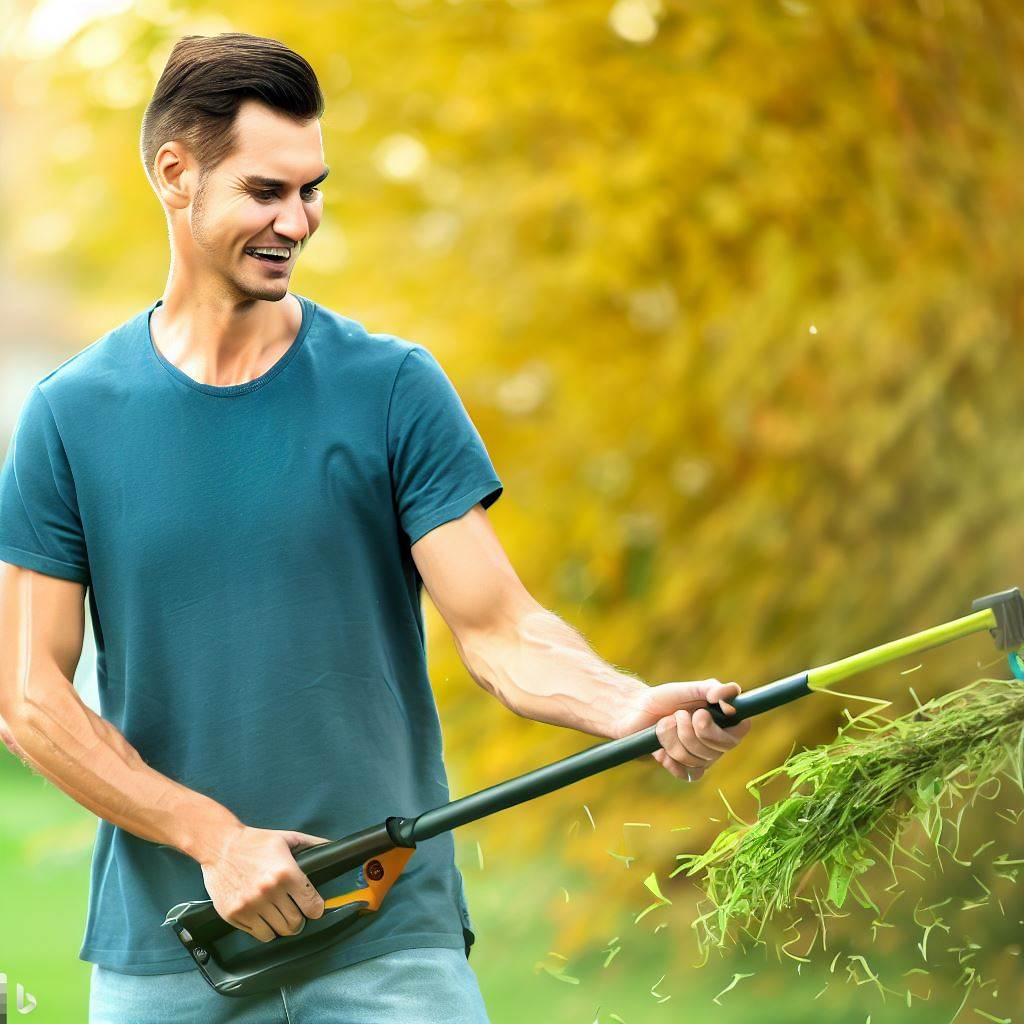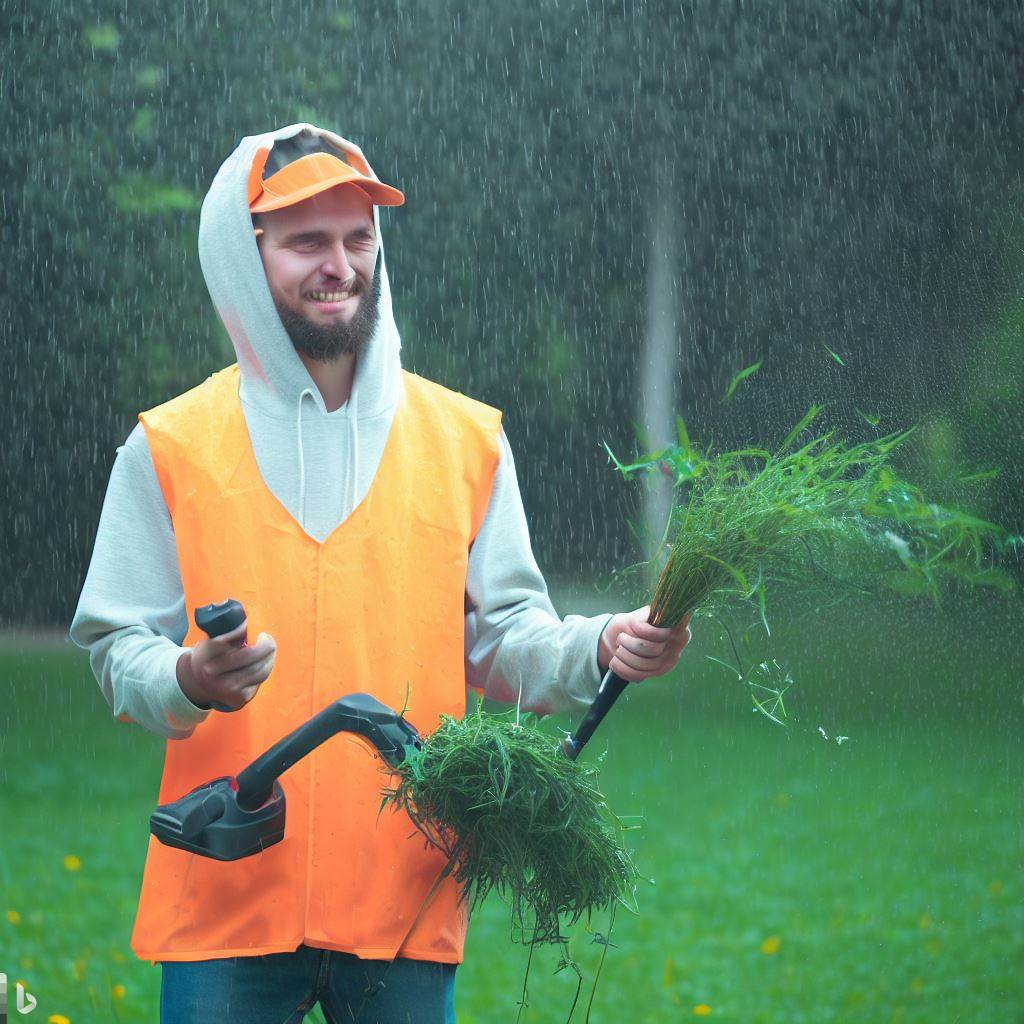So, you’re standing there, gazing across your saturated lawn after a hefty rain shower. Your weed whacker is in hand and you’re itching to neaten up that untidy yard. But suddenly you pause; a question bubbles up from the depths of your green-thumbed mind: Can we actually weed whack when it’s wet?
Well, I’m here to tell you – hold off on that urge! It might be tempting but using a weed whacker on wet grass isn’t the best idea. In fact, it could lead to an uneven cut and potential damage both to your lawn and the equipment itself.
You see folks when we invite nature into our lives through gardening, questions are bound to sprout just as fast as those pesky dandelions do after spring showers. The good news is that we don’t have to tumble down every rabbit hole alone. So whether it’s about choosing the right tools or knowing when not to use them- stick around for insights sure ignite sparks of ‘aha!’ moments in your DIY landscaping journey!
Here is an article you might be interested in ceiling heaters for porches
Here is also another exciting article to read charcoal alternative for grilling
Risks and Drawbacks of Weed Whacking When It’s Wet
We all know that taming our unruly yards can be quite the task. And when it comes to weed whacking, things can get even trickier, especially when Mother Nature decides to pour down on us.
So, the burning question arises – can you weed whack when it’s wet? Well, before we dive into this mystery, let’s first explore the risks and drawbacks of taking out your trusty weed whacker in less-than-ideal conditions.

When you decide to embark on a wet weed-whacking adventure, there are several hazards you need to consider. First and foremost is safety! The moisture from rain or dew creates slippery surfaces that increase the chances of accidents. Imagine yourself zipping through your lawn with a powerful tool in hand only to lose your balance due to those sneaky wet patches. Ouch!
Not only do we have safety concerns swirling around like overgrown dandelions in the wind but also potential damage to our precious equipment.
The damp grass clippings tend to cling stubbornly onto every nook and cranny of our beloved weed whackers, clogging them up faster than a lazy river ride at a water park on a hot summer day.
And speaking of clogs (no pun intended), another drawback is reduced efficiency during wet conditions. Wet grass tends to stick together in clumps instead of being dispersed neatly by the spinning string or blades of your trimmer. This not only slows down progress but also affects how evenly your lawn gets trimmed.
But hey now, don’t throw away those gardening gloves just yet! There are precautions you can take if you’re determined enough for some moist mowing action.
Precautions To Take If Weed Whacking In Wet Conditions
Before venturing into the realm of trimming wet vegetation with gusto and determination reminiscent of a superhero, it’s important to implement some safety measures. So, here are a few tips to help you navigate the wet weed-whacking terrain:
1. Dress Appropriately
Don’t underestimate the power of proper attire! Make sure you wear non-slip footwear and choose clothing that provides good traction. Consider donning rain gear or waterproof clothing to keep yourself as dry as possible.
2. Mind Your Surroundings
Be mindful of potential hazards in your yard, such as rocks, tree roots, or hidden objects that might be more difficult to see when everything is wet and slippery. Keep an eye out for uneven surfaces that could trip you up faster than a misplaced rake.
3. Inspect Your Equipment
Before starting your wet weed-whacking adventure, take the time to inspect your equipment thoroughly. Ensure all components are properly tightened and functioning well – nobody wants loose bits flying off into the unknown! Also, clean any debris from previous sessions so those clogs won’t plague you mid-trim.
4. Choose The Best Time
Timing is everything in life – and even more so when it comes to engaging in soggy grass-cutting sessions! Try waiting until later in the day when things have had a chance to dry out slightly but aren’t bone-dry yet.
5. Adjust Your Technique
When tackling moist mowing tasks, consider using shorter strokes while maintaining control over your trimmer at all times (like a graceful dancer on slippery ice). This way, you can manage clumping issues relatively effectively while keeping safety front and center stage.
By implementing these precautions with care and diligence, you’ll be well-equipped for trimming wet grass without succumbing to Nature’s slippery tricks!
Effect Of Moisture On Different Types Of Weeds During Trimming
Now let us dive deeper into another intriguing aspect of weed-whacking quandaries – how does moisture influence our leafy adversaries? Not all weeds are created equal, and neither is their reaction to the rainy stage of an amateur gardener’s thrilling pursuit!
Moisture has a varied impact on different types of weeds during trimming. Some delicate plants may surrender quickly when they encounter damp conditions, while others might prove to be surprisingly resilient. It’s like a battle royale happening right inside your yard!
For example, broadleaf weeds with shallow roots tend to flop under the weight of wetness more readily than their deep-rooted counterparts. Those flat leaves act as perfect little moisture traps, clinging onto every raindrop or dewy embrace that comes their way.
On the other hand, grassy weeds such as crabgrass or Dallisgrass can rally against moist mowing attempts thanks to their sturdy root systems. They’ll gladly soak up all those drops without missing a beat – like raincoat-clad dancers gracefully twirling in the storm.
So next time you’re faced with a stubborn weed army in wet conditions, remember that each intruder requires its own calculated approach for effective elimination.
Influence Of Wetness On The Efficiency And Lifespan Of The Weed Whacker
Ah, our trusty weed whackers! These mighty machines have become our steadfast companions throughout our battles against unruly vegetation. But alas! Wet conditions can put even the most loyal trimmer through quite the test of endurance and efficiency.
The moisture from soggy surroundings tends to hamper various components of your beloved weed whacker. Firstly, those spinning strings or blades will face resistance due to clumping caused by wet grass sticking together like overly affectionate newlyweds on honeymoon.
This clumping not only reduces cutting efficiency but also creates additional strain on your trimmer’s motor system. Imagine pushing through dense masses of tangled foliage instead of enjoying smooth glides over neatly trimmed lawns – it’s like trying to breakdance through quicksand with lead shoes!
Additionally, let’s not forget the dangers of clogs! Wet grass clippings are notorious for adhering to every part of your weed whacker with tenacity rivaling that of a squirrel guarding its acorn stash.
These clingy culprits can hinder ventilation, damage delicate components, or even cause overheating – a nightmare no gardener wants to face.
But fear not, fellow green warriors! By taking proper care and maintenance measures after wet trimming sessions, you can ensure your trusty tool stands strong against these watery challenges. Clean out those clinging cuttings, dry off any damp surfaces diligently, and store your trimmer in a safe place away from moisture’s cunning grasp.

Role Of Weather Considerations For Optimal Weed Control
Weather plays a pivotal role in our quest for pristine lawns and gardens. And when it comes to efficient weed control, paying attention to weather considerations is just as important as selecting the perfect gardening gloves!
Timing is key when combating pesky weeds. Dry periods following rainfall provide an optimal opportunity for effective trimming without battling excessive moisture levels. The absence of rain or dew allows grass and other vegetation to dry out slightly while maintaining enough hydration for healthy growth.
However, it’s essential to strike the right balance between waiting for ideal drying conditions and preventing weeds from getting too established in the meantime. Finding this sweet spot may require some investigative skills that Sherlock Holmes himself would envy!
Conclusion
When it comes to weed whacking in wet conditions, safety and effectiveness should be your top priorities. While it may be tempting to tackle those overgrown weeds regardless of the weather, it’s crucial to consider the potential risks involved.
Remember, a little patience can go a long way in preserving your well-being and achieving optimal results. So, the next time you’re faced with wet conditions, take a moment to assess the situation and apply the knowledge gained from this guide. Happy and safe weed-whacking!
Read another exciting blog post here charcuterie on butcher paper
This is the article to read for today chateaubriand reverse sear
FAQs
Q: Can I weed whack when it’s wet outside?
A: It’s generally not recommended to weed whack in wet conditions. Wet grass can make it more difficult to cut and the weed eater may be less effective. It’s best to wait for the grass to dry before using a weed eater.
Q: Can I use an electric weed eater when the grass is wet?
A: It’s usually not advisable to use an electric weed eater on wet grass. The electrical components can be damaged when exposed to moisture. Wait for the grass to dry before using an electric weed eater.
Q: Is it safe to weed eat after it rains?
A: While it may be tempting to tackle the weeds right after it rains, it’s best to wait until the grass is dry. Using a weed eater on wet grass can be more challenging and may not provide the desired results.
Q: Can I weed whack wet grass?
A: It’s generally not recommended to attempt weed whacking on wet grass. The wet surface can make it difficult for the weed eater to cut through the grass effectively. Waiting for the grass to dry will make the task easier.
Q: Should I trim wet weeds with a weed eater?
A: It’s best to avoid using a weed eater on wet weeds. The dampness can make the task more challenging and may result in a less tidy cut. Wait for the weeds to dry before using a weed eater for better results.
Q: Can I cut wet grass with a weed eater?
A: It’s generally not recommended to cut wet grass with a weed eater. The wet grass can be more difficult to trim effectively, and the weed eater may not provide the desired results. Wait for the grass to dry before using a weed eater.
Q: Is it safe to weed whack in the rain?
A: It’s not safe to use a weed eater in the rain. Water and electricity don’t mix well and using an electrical tool like a weed eater in wet conditions can be dangerous. It’s best to wait for the rain to stop before using a weed eater.
Q: Can I use an electric weed eater in wet weather?
A: It’s not recommended to use an electric weed eater in wet weather. Moisture can damage the electrical components of the tool and pose a safety hazard. Wait for the weather conditions to improve before using an electric weed eater.
Q: Is it safe to weed eat in the rain?
A: No, it is not safe to use a weed eater in the rain. Using electrical tools in wet conditions can be hazardous. Wait for the rain to stop and the grass to dry before weed eating.
Q: Can I weed whack tall grass?
A: Yes, you can definitely use a weed eater on tall grass. However, it may require more effort and you may need to use a higher cutting setting or make multiple passes to achieve the desired results.
